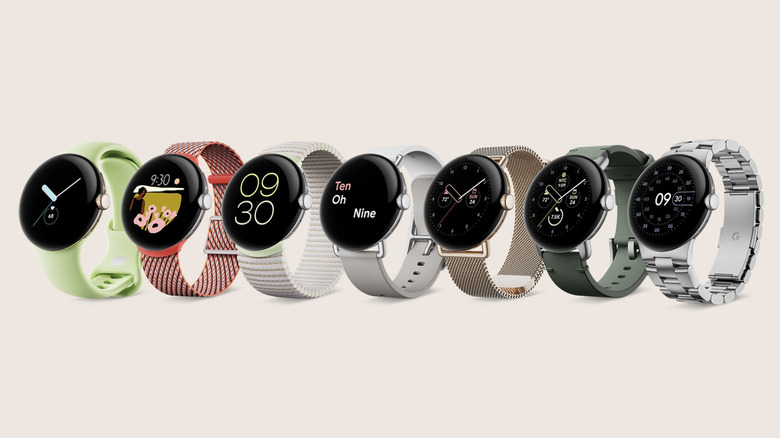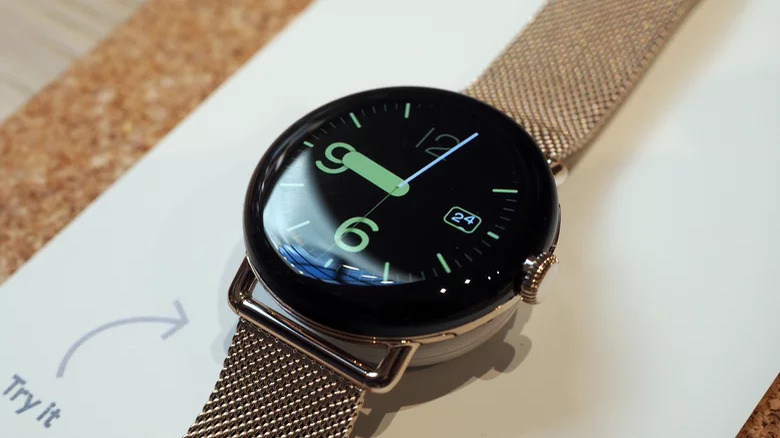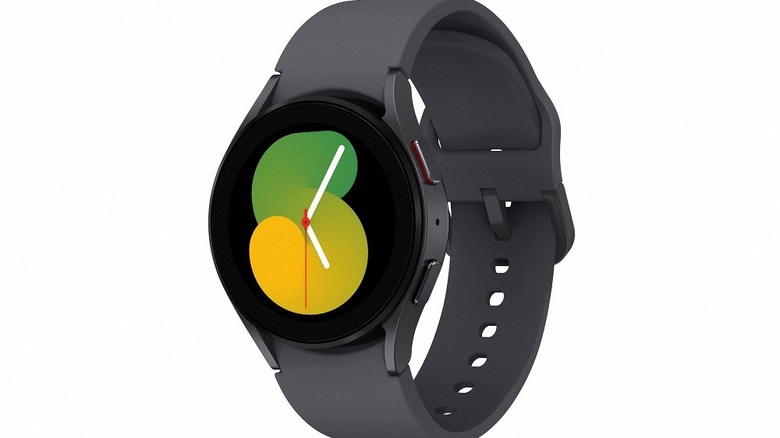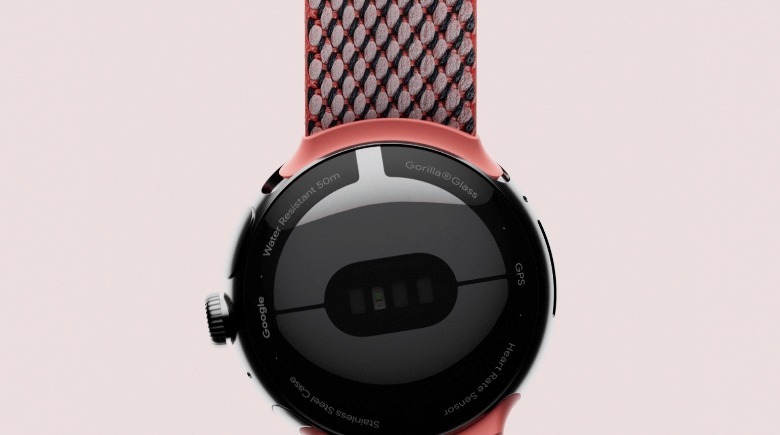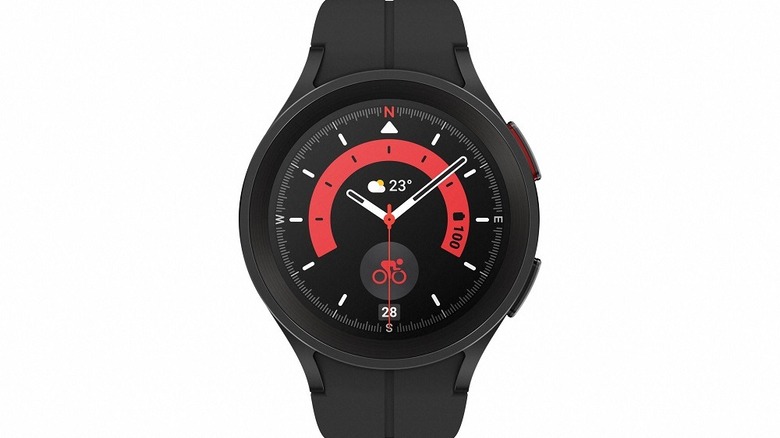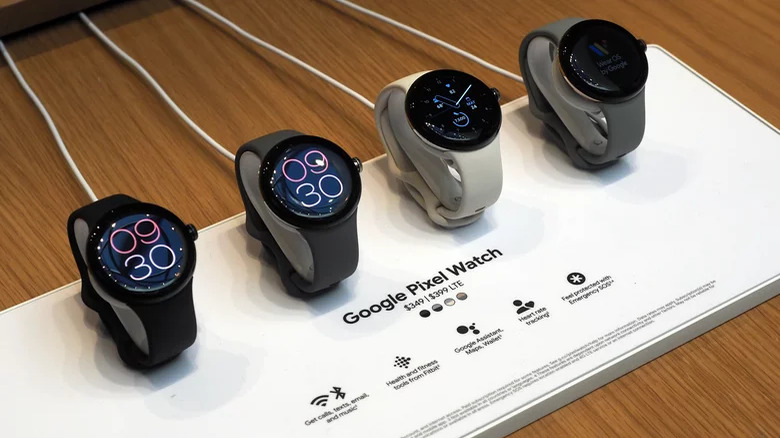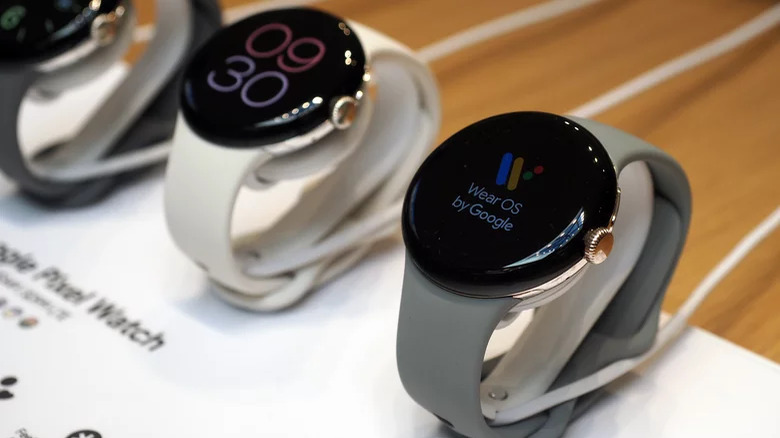Google Pixel Watch Vs Samsung Galaxy Watch 5: The Big Differences Explained
We may receive a commission on purchases made from links.
Google's Wear OS (previously Android Wear) is one of the oldest platforms for smartwatches to run on, first appearing on the LG G Watch in 2014. Despite this legacy, Google entered late into the smartwatch hardware market. At the 2022 Pixel launch event, Google launched the Pixel Watch, lending Wear OS a unique identity in a market dominated by the Apple Watch, Samsung Galaxy Watch, and fitness trackers with custom software.
The Pixel Watch lacks impressive hardware but relies on Fitbit's fitness smarts for highly-accurate fitness tracking that Google inherits as a result of its Fitbit buyout. Besides fitness, the Pixel Watch offers a pure Wear OS software experience.
For several years, the Samsung Galaxy Watch has been among the top choices for Android users who want a well-rounded smartwatch. In 2021, Samsung replaced its custom Tizen operating system with a combination of Wear OS and Tizen for its smartwatches. Despite plenty of Wear OS smartwatches, none seem as well-rounded as the Galaxy Watch.
Like the Pixel smartphones, the Pixel Watch is intended to be at the center of software development for the Google-backed smartwatch interface. Because Google also licenses the Wear OS interface to a myriad of other watchmakers, the Pixel Watch can be expected to refine the software experience. This makes the Pixel Watch a desirable choice for anyone who wants to experience these features over form. If you are confused about which smartwatch to choose between the Pixel Watch and the Galaxy Watch 5, our comparison should help put your confusion to rest.
Pixel Watch deceives with its looks
The biggest and most apparent difference between the Pixel Watch and the Galaxy Watch 5 is their sizes. The Pixel Watch comes in a single size with a 41mm circular dial made from 80% recycled stainless steel (via Google). The Galaxy Watch 5 is available in 40mm and 44mm variants, while the Galaxy Watch 5 Pro comes with a 45mm dial (via Samsung). The smaller Watch 5 devices utilize aluminum shells, while the Galaxy Watch 5 Pro's body is crafted with titanium.
Even as the differences in size between the Pixel Watch and the Galaxy Watch 5 models will be easier to observe when they are put side-by-side, there is a noticeable difference between how these watch look. The Pixel Watch uses a layer of Gorilla Glass 5 to sheath the display. The glass is curved along the periphery, and the bezels blend into the chassis, making it appear connected. On the other hand, all Galaxy Watch 5 variants use sapphire crystal glass along flat edges. While looks are subjective, the Pixel Watch's curved edges are deceiving because the curved part of the glass only covers the bezels underneath and not an active part of the touchscreen.
The Pixel Watch gets a rotating crown and a button on the right side. Meanwhile, the Galaxy Watch 5 and the Watch 5 Pro feature two buttons on the right that can be inverted if you prefer to wear the watch on your opposite wrist.
Identical displays
According to Google, The Pixel Watch's AMOLED display measures 1.2-inches with a pixel density of 320ppi (pixels per square inch). Google claims the display can illuminate to a high brightness of up to 1,000 nits. Meanwhile, the 40mm Galaxy Watch 5 also gets a 1.2-inch AMOLED display, while the 44mm Galaxy Watch features a 1.4-inch AMOLED display (via Samsung). Despite the bigger dial, the Galaxy Watch 5 Pro also sports a 1.4-inch AMOLED display. The pixel densities of the different Galaxy Watch 5 models are comparable to the Pixel Watch. All the watches also feature always-on displays.
In terms of durability, the Pixel Watch and the Galaxy Watch 5 models fare equally well underwater. All watches offer resistance at up to 5-meters of depth or 5 atmospheres of pressure under fresh water. It is to be noted that these claims may vary in other sources of water, especially seawater, and any type of water-related damage is not covered under warranty. The Galaxy Watch 5 and the Watch 5 Pro also get an IP68 rating, ensuring protection against dust, and MIL-STD-810H certification.
Regarding the bands' replacement, the Pixel Watch uses a custom mechanism for attaching or detaching straps. Although that makes the process very simple and convenient, you will be restricted to bands that are either officially sold by Google or endorsed by it — at least initially. The Galaxy Watch 5, on the other hand, uses a single lug pin mechanism, making it universally compatible with any watch band that fits.
Features locked behind paywalls
Fitness remains central to smartwatches, and both watches do well in this respect. The Pixel Watch features an optical sensor for heart rate measurement, a staple to any modern smartwatch. It also packs in a SpO2 tracker, which has not been enabled yet (via Google).
Google leverages its machine learning expertise to build upon Fitbit's already comprehensive workout algorithms to track activities more precisely. By default, the Pixel Watch has 40 workout modes that can be tracked straight from the Watch. Users will also be able to unlock 1,000 different workout modes if they buy a Fitbit subscription, the first six months of which are free. Google says the Pixel Watch is also capable of performing an electrocardiogram (ECG).
In comparison, the Galaxy Watch 5 and the Galaxy Watch 5 feature a photoplethysmography (PPG) sensor for heart rate and SpO2 measurement. The Watch 5 variants also feature a Bio-Electrical Impedance (BIA) sensor that is utilized to measure body composition as well as for ECG (via Samsung). In addition, the watches can measure your blood pressure and — in theory — wrist temperature. Many of these features, including wrist temperature, BP monitoring, and ECG, are limited to regions where Samsung has approval from FDA-like regulatory bodies.
The Galaxy Watch can track over 90 different workout modes (via Samsung), but you can also subscribe for paid workout and sleep consultations.
Pixel Watch's battery is seemingly insignificant
Flagships smartwatches, including the Apple Watch, set a pretty low bar for the battery's performance, and the Pixel Watch does not surprise much. It comes with a 294mAh battery with a claimed 24-hour battery life (via Google).
The Galaxy Watch 5 models, on the other hand, come with varying battery sizes as per the model. The 40mm Watch 5 features a 284mAh battery, while the 44mm version comes with a much larger 410mAh battery. Samsung claims these batteries can last almost 40 hours.
The Galaxy Watch 5 Pro features an even larger 590mAh battery that lasts over two days (via Samsung).
When it comes to charging, watches from both Google and Samsung feature wireless Qi-compliant charging. While the charging rate on the Pixel Watch is capped at 5 watts, the Galaxy Watch 5 and the Watch 5 Pro can charge twice as fast — at 10 watts. It is to be noted that despite Qi compliance, the Galaxy Watch 5 will not charge with any non-Samsung charger and this limitation appears to have been implemented by Samsung by design.
Performance and features
In terms of software experience, there are visual differences between stock Wear OS and Samsung's custom Galaxy Watch interface. Although both watches run on Wear OS 3.5, Samsung uses a custom overlay on top of it that still looks like its older smartwatches based on Tizen OS (via Samsung). You will notice fundamental differences in how the app launcher, settings app, quick settings toggles, and app tiles appear. Notably, Google promises three years of software support for the Pixel watch while Samsung offers four years (via Wired).
Under the hood and in terms of the experience, however, things aren't starkly different. You can download and run the same variety of apps. On these smartwatches, you can access apps such as Strava, Adidas Running, Nike Run Club, My Fitness Pal, etc. As mentioned above, you can also get exclusive subscription services with both varieties of smartwatches.
In terms of performance, the Pixel Watch uses a Samsung Exynos 9110 processor and an M33 co-processor (via Google). The 11nm chipset is four years old and was first deployed on the Galaxy Watch Active2 in 2019. In contrast, the Galaxy Watch 5 uses a much more advanced and efficient Exynos W920 processor fabricated with a 5nm process.
However, the Pixel Watch makes up for its shortcoming in processing power through a larger 32GB storage and 2GB of RAM compared to 16GB and 1.5GB on Galaxy Watch 5 models.
Pricing dominates your choice
The Pixel Watch is available for a starting price of $349.99 for the Wi-Fi-only variant, while the cellular variant will cost you $399.99 at Google's Play Store.
The Galaxy Watch 5 40mm is priced at $279.99 for Wi-Fi and $329.99 for the LTE models. The 44mm variants are priced at $309.99 and $359.99 for the non-cellular and cellular variants, respectively at Samsung's website.
The Galaxy Watch 5 Pro starts at $449.99 for the regular variant, and the LTE variant goes up to $499.99 also on Samsung's website. These prices are exclusive of your local taxes and may not translate via direct currency conversion in other countries.
The pricing of the Pixel Watch and the Galaxy Watch 5 models narrows the competition, allowing us to streamline the choices. The Pixel Watch goes straight up against the non-Pro variants of the Galaxy Watch, offering a purer Android experience but at the cost of crucial features and an attractive design. Depending on your priority, you will be able to make a better decision between the available choices.
